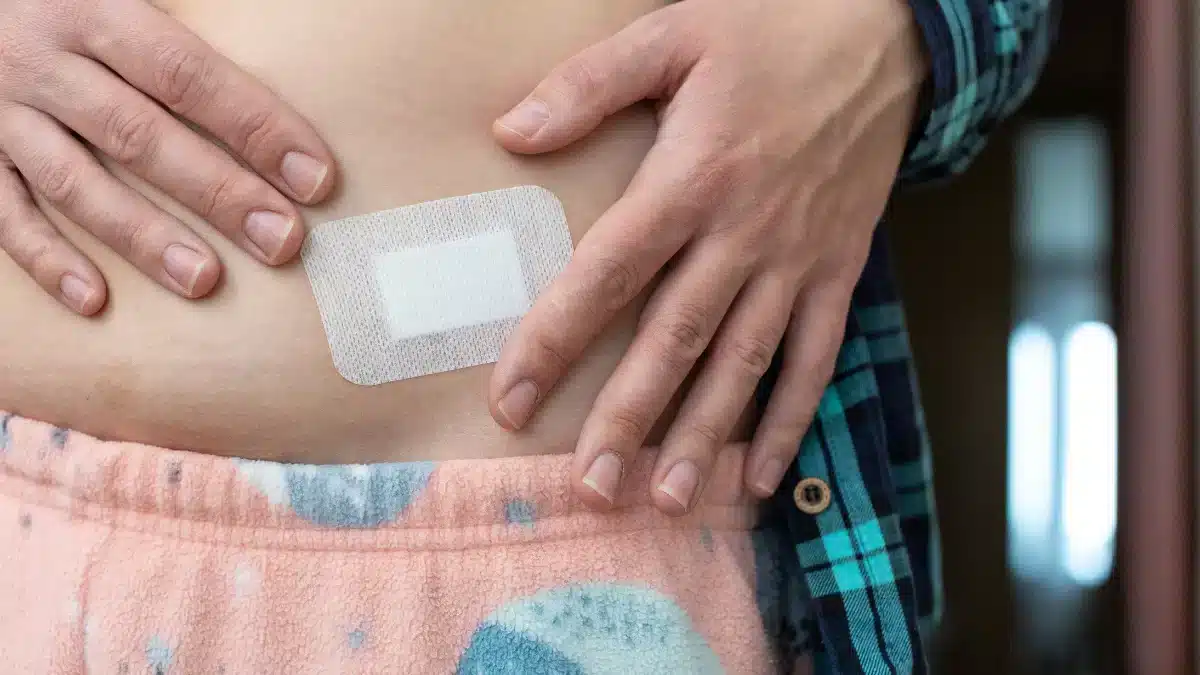The Birth Control Patch: Exploring its Working, Effectiveness, Advantages, and More
The birth control patch stands as a modern and convenient contraceptive option. It offers high effectiveness and ease of use.
This transdermal contraceptive patch is available under various brand names and has gained popularity for its benefits in providing reliable contraception.
However, like any medical intervention, it may also present potential health risks and side effects.
That is why it becomes crucial to engage in open conversations with healthcare providers who can provide personalized guidance.
In this article, we will discover all these aspects of the contraceptive patch in detail.
What is a birth control patch
The birth control patch is also known as a transdermal contraceptive patch.
It is a slim, square patch that attaches to the skin, releasing hormones through the skin into the bloodstream.
This helps in preventing pregnancy and provides users with a practical and user-friendly contraceptive option.
How contraceptive patch works
The birth control patch operates through the release of hormones into the bloodstream.
Typically, it contains two synthetic hormones, Estrogen and Progestin.
These two work together to inhibit ovulation, thicken cervical mucus, and alter the uterine lining to discourage the implantation of a fertilized egg.
Birth control patch effectiveness
Birth control patches boast an efficacy rate of more than 99%.
Its effectiveness is based on consistent and correct usage.
A study published by the National Library of Medicine in 2008 examines the comparison of contraceptive effectiveness.
This research looks at how well the patch performs in preventing pregnancies. 573 women were participated in the study over six months.
Findings suggest that the patch was reliable, with a low pregnancy rate (Pearl Index of 0.43), comparable to other contraceptives.
A further study compared the patch with oral contraceptives in real-life conditions.
The probability of pregnancy with the transdermal contraceptive patch was found to be lower than that of oral contraceptives across all age groups.
This indicates that the patch’s effectiveness is expected to be more than that of oral contraceptives due to a higher rate of perfect use.
How to apply the patch correctly
Using the birth control patch is an easy process.
It is crucial to follow the instructions given by healthcare providers and the specific guidelines given with the patch you are using.
Here’s a general guide on how to use the birth control patch:
Get a prescription

Before starting any form of birth control, it’s crucial to consult with a healthcare provider.
They will assess your medical history, like weight and blood pressure, discuss potential side effects, and determine whether the birth control patch is a suitable option for you.
Once your healthcare provider has recommended the birth control patch, they will provide you with a prescription.
You can then obtain the patch from a pharmacy.
Understand the patch cycle
The birth control patch is typically used in a three-week cycle.
During the fourth week of your cycle, do not wear a patch.
This is the patch-free week when you will likely experience withdrawal bleeding.
After the patch-free week, start a new patch cycle promptly to maintain contraceptive effectiveness.
Choose where to place the patch
Select a clean, dry area on your skin for patch placement.
Common areas include the buttocks, abdomen, upper outer arm, or upper torso (excluding the breasts).
Rotate the placement area with each new patch to prevent skin irritation.
Apply the patch
When applying the patch, it’s crucial to read the accompanying leaflet thoroughly or follow healthcare guidance.
Proper understanding of the instructions ensures correct application and maximizes the effectiveness of the contraceptive patch
Follow these steps to apply the patch:
- Peel off the protective backing of the patch to expose the adhesive side
- Press the patch firmly onto the chosen area, ensuring good skin contact
- Smooth out any air bubbles to help the patch adhere properly
Change the patch weekly
Change the patch every week on the exact same day to maintain its effectiveness.
It’s advisable to set a reminder to ensure timely replacements.
Be consistent
Consistency is key for the birth control patch to be effective.
Apply patches on schedule and follow the prescribed cycle to maximize its contraceptive benefits.
What to do if my patch falls off
The contraceptive patch is designed to stay securely in place, even during activities like showering, bathing, swimming, or exercising.
However, if the patch falls off, here are some guidelines on what you should do:
| Aspect | Steps to take |
|---|---|
| If the patch has been off for less than 48 hours | 1. Stick the patch back on as soon as possible if it’s still sticky 2. Otherwise, replace it with a new one. Do not attempt to hold the old patch in place with a plaster or bandage 3. Continue using the patch as usual, and change it on your regularly scheduled change day 4. You can still be protected against pregnancy if the patch was properly on for 7 days before it came off additional contraception is needed in such a case |
| If you have had the patch on for 6 days or less before it falls off | 1. Apply a new patch as soon as possible 2. Use additional birth control, such as condoms, for the next 7 days to ensure continued protection against pregnancy |
| If the patch has been off for 48 hours or more, or you’re unsure how long it has been off | 1. Apply a new patch as soon as possible, and consider this day as the start of a new patch cycle 2. Use an additional form of contraception for the next 7 days to ensure contraceptive efficacy |
Side effects

Like any hormonal contraceptive, the birth control patch may come with side effects.
Common side effects include the following:
- Bleeding or spotting between periods
- Breast tenderness
- Mood swings
- Menstrual pain
- Vaginal discharge
- Headaches
- Skin irritation
- Acne
- Fluid retention
- Diarrhea
- Muscle spasms
- Fatigue
Keep in mind that this is not a complete list.
Different people may experience different side effects.
It’s essential to talk to a doctor about any concerns and find the best contraceptive method for you.
Regular check-ups with healthcare providers help monitor how your body responds to the birth control patch and address any issues.
Pros and cons of birth control patch
The transdermal contraceptive patch comes with both pros and cons.
This section will explain these in detail.
Advantages of the contraceptive patch
There are several advantages of the contraceptive patch.
Some of them include the following:
- Effective and convenient long-term birth control
- Health benefits include lighter periods and reduced PMS symptoms
- Predictable menstrual cycles
- Easy application and removal
- No daily pill to remember
- Improvement in acne
Disadvantages of the contraceptive patch

There are a few disadvantages of the contraceptive patch.
Some of them include the following:
- Visible on the body
- Requires weekly maintenance
- Prescription is necessary
- Potential for skin irritation
- Risk of the patch falling off
- No protection against STDs and HIV
STDs (Sexually Transmitted Diseases) are infections transmitted through sexual contact.
HIV, also called Human Immunodeficiency Virus, attacks the immune system, primarily spreading through unprotected sex and blood-to-blood contact.
Who should not use this
While the birth control patch is suitable for many women, it may not be appropriate for everyone.
Women with a history of blood clots, cardiovascular issues, breast cancer, and liver disease should avoid the patch.
Additionally, those who smoke and are over 35 years old should consult their healthcare provider to explore alternative contraceptive options.
Is birth control patch costly
The cost of the birth control patch varies based on several factors like location, brand, and insurance coverage.
Generally, it falls within a comparable range to other hormonal contraceptives.
Under the Affordable Care Act, the cost of birth control is covered by most insurance plans.
It makes the patch an affordable option for various users.
To get accurate and specific cost details, it’s recommended to contact your healthcare provider or pharmacy or check with your insurance plan.
Conclusion
The birth control patch is a contraceptive option that adheres to the skin.
It works by releasing synthetic hormones, Estrogen and Progestin.
The patch has an efficacy rate of 91-99% in preventing pregnancy, but its cost can vary.
There are various benefits of the contraceptive patch, like lighter periods, reduced PMS symptoms, and potential improvement in acne.
However, users must be aware of adverse side effects, such as spotting between periods, headaches, skin irritation, and more.
It’s crucial to consult with a doctor to discuss concerns and find the most suitable contraceptive method.
Regular check-ups are essential for informed decision-making in matters of reproductive health.
Ultimately, the decision to use a particular form of contraceptive should be based on an individual’s lifestyle, health considerations, and personal preferences.
Frequently Asked Questions
What happens if my patch falls off?
If your birth control patch falls off for less than 48 hours, promptly reapply it or use a new one if no longer sticky. Continue your regular patch cycle. If it’s off for more than 48 hours or the duration is uncertain, apply a new patch with additional contraception. It will help prevent pregnancy.
What are the disadvantages of the patch?
The birth control patch comes with several disadvantages. Some of them include its visibility on the body, weekly maintenance requirements, the need for a prescription, and lack of protection against STIs. Consulting with healthcare providers is essential to consider these drawbacks alongside the method’s benefits carefully.
Is the patch a good birth control?
Yes, the birth control patch is considered a good contraceptive option for many individuals. It offers high effectiveness when used consistently and correctly. Its convenience, requiring a weekly application, can make it a practical choice for those seeking a reliable form of birth control.Â
How much does the patch cost?
The cost varies based on factors such as location, brand, and insurance coverage. Generally falling within a comparable range to other hormonal contraceptives. Many insurance plans cover the patch, making it more affordable. For specific cost details, contact your doctor, or pharmacy, or check with your insurance plan.
WowRx uses only high-quality sources while writing our articles. Please read our content information policy to know more about how we keep our content reliable and trustworthy.






